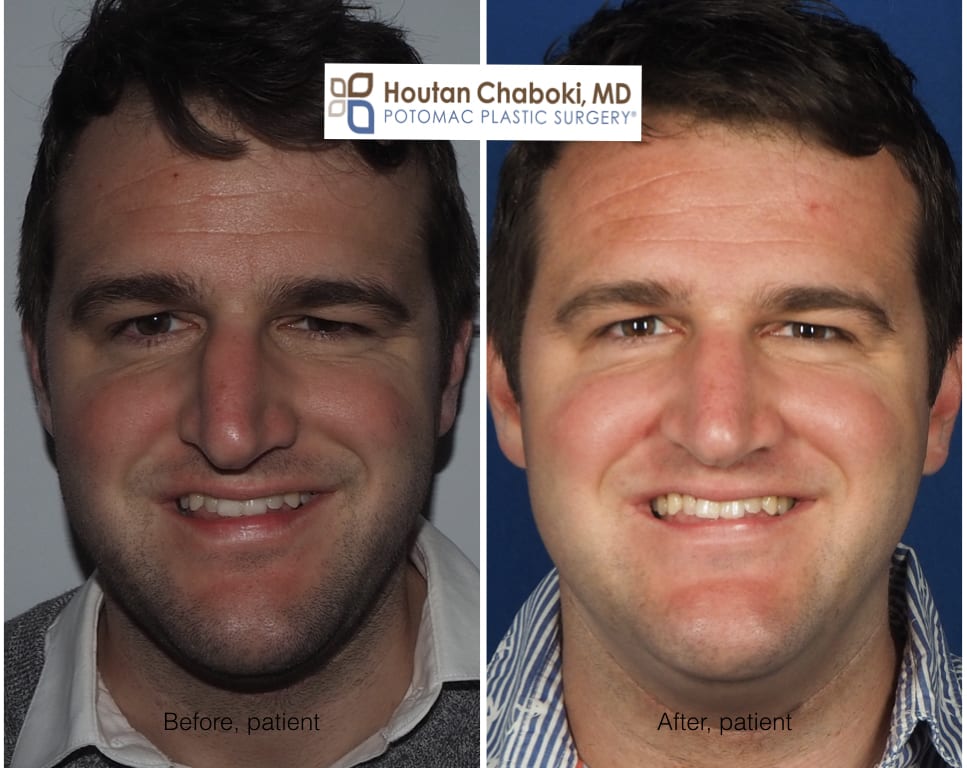
Closed, preservation rhinoplasty can straighten a deviated nose and avoid external scars.
Rhinoplasty is often considered to make a nose smaller. Plastic surgeons, however, generally consider rhinoplasty to balance the appearance of the nose with the face. Enhancing symmetry can help improve this balance and proportion.
Patients complaing of body asymmetry is common in a plastic surgeon’s office, as everyones eyes, breasts, and nose are asymmetric. A variable degree of asymmetry is normal and expected, especially of the nose. Being in the central part of the face, the nose is susceptible to growth disparities of various facial components during development. In addition, the nose is also vulnerable to injury as it sits away from the face.
Rhinoplasty is usually required to improve a crooked nose, and preservation rhinoplasty is an excellent surgical method to improve symmetry.
Preservation Rhinoplasty
Dr. Chaboki specializes in various aspect of nasal surgery, including cosmetic rhinoplasty, septoplasty, and endoscopic sinus surgery. Preservation rhinoplasty is a relatively advanced technique that allows a plastic surgeon to modify the nose while preserving normal anatomy, as much as possible. One benefit of preservation rhinoplasty is that it allows one to straighten a twisted nose.
Read more about preservation rhinoplasty in our blog.
Deviated Nose
A crooked or deviated nose has many causes. The most common is a deviated nasal septum, the wall of cartilage and bone that separates the nose into a right and left side. While septoplasty is required to improve the nasal airway for patients with a deviated septum, a rhinoplasty is often required to improve the external asymmetry of patients with a deviated septum. Routine septoplasty alone is usually insufficient to treat a twisted, crooked, or deviated nose. Plastic surgeons will modify the nasal bones during rhinoplasty surgery in order to straighten a crooked nose.
Read more about deviated septum surgery in our blog.
Nasal Bone Reshaping
Nasal bone reshaping and modification involves osteotomy. Osteotomy is performed to modify the bone. Typically reasons for osteotomy include:
- Wide bridge – patients with wide bridge and nasal bones may need the bones brought in closer together to create a narrow appearance. However, those with a flat nose or “no bridge” create narrowing during rhinoplasty without bone reshaping.
- Deviated nose – a twisted or crooked nose often requires osteotomy to reposition the nasal bones and make the nose more symmetric. Often rhinoplasty is combined with septoplasty for these patients with a deviated nose.
- Large bump – a large bump often necessitates osteotomy to make the nasal bones more harmonious after hump reduction.
Top plastic surgeons who perform preservation rhinoplasty will typically reshape the nasal bones with specialized osteotomy.
Have you considered rhinoplasty for a deviated nose? Contact the office and see if you’re a candidate for preservation rhinoplasty.

When is the Earliest surgery date for revision rhinoplasty?
Thank you for reading blog!
Minor “tweaks” might be an option in the office via local anesthesia. However, plastic surgeons generally recommend waiting one year after rhinoplasty surgery before considering revision surgery.
Best,
Dr. Chaboki